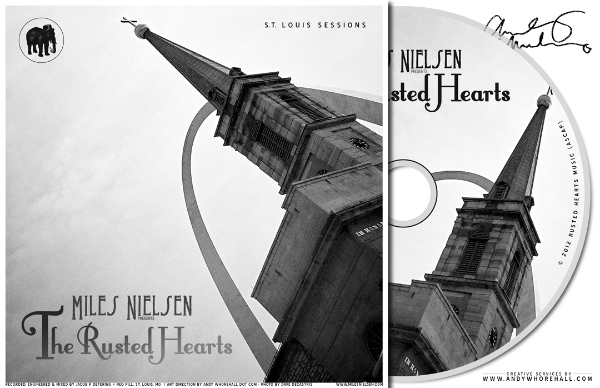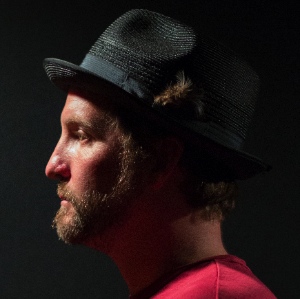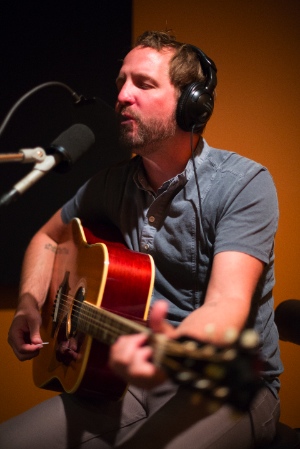 Yesterday, we began Popdose’s Red Pill Sessions series with an introduction to both the concept – in which artists have two days to write and record four songs – and to our first participant, Miles Nielsen and the Rusted Hearts. Today, we interview Nielsen about the experience and one of the songs they recorded during the sessions, “Sink Or Swim.” Below the interview is a video of the band recording the song at Red Pill‘s studio in St. Louis.
Yesterday, we began Popdose’s Red Pill Sessions series with an introduction to both the concept – in which artists have two days to write and record four songs – and to our first participant, Miles Nielsen and the Rusted Hearts. Today, we interview Nielsen about the experience and one of the songs they recorded during the sessions, “Sink Or Swim.” Below the interview is a video of the band recording the song at Red Pill‘s studio in St. Louis.
“Sink Or Swim,” and three other songs, were written and recorded in the studio over a period of two days. How did the writing process start? Had a line or two or a chord progression been in your head and you developed it from there or was it start-to-finish in the studio?
I just had the opening line to “Sink or Swim.” We went in with one tune sort of put together, which was “Tokyo,” and after we recorded that, we were like, “OK, now what?” I had a fragment of another tune and then, while they were doing some of the different parts, I went upstairs into the lounge and finished a tune called “Ten Feet Tall.”
About midnight, we wrapped up for the day and we all said, “We can either do some older tunes in a different way,” and we all agreed that we didn’t want to do that. We thought, “Well, let’s try to push ourselves and get a couple of songs done here. So we sat up until about 3:30 in the morning and hammered out a couple of songs. “Sink or Swim” and “The Best I Can” came out between 12:30 AM and 3:30 AM.”
Given that this was all done in two days, that doesn’t give you a lot of time to fine-tune it. You can generally get away with that when it comes to the music in terms of the chords, but is that tough for you as a lyricist to go with something that’s more or less a first draft?

On the first draft there were definitely some scribbles on the page and some things that I was taking out as we were going. As we were rehearsing through it, there was still a bridge that I wasn’t really solid on, and once we started tracking, I said, “I need, like, 20 minutes and I need to get in the headspace and get something done here.”
It was easy because it was such a fast-paced thing. If I’m any good at writing songs with all the hard work I’ve put in to becoming a writer, I should be able to access that place. Thankfully, this studio is conducive to a creative environment, and I was able to write some lyrics that I liked. I like where it went.
What did you gain from the experience of having to work in such a condensed time frame that you can bring to your future work? I know that some creative people like constraints – self-imposed or otherwise – and some don’t, so where do you fall on that scale?
I have a studio at home in Rockford, Il. and we run ProTools, so I think [recording to 2″ analog tape] was great. It really forced us to sort of flex our muscles as musicians and singers. There were three or four of us in the room at the same time all recording around a microphone singing harmony parts that we were having to do live.
It’s maybe not for everyone, but we’ve all done this enough and sang together enough that it worked out pretty well. We’re talking about going back and doing more and saying, “You know what? Let’s make it a plan to go analog, stick to 24 tracks and leave it at that.”
This was a great experience for us. I know [Red Pill co-owner/producer] Jacob [Detering] was really, really into it. We had a great time doing it and hopefully some other bands can do the same thing here.
I’m glad you mentioned the background vocals, because they and the finger snaps are a bit of a surprise. They’re like Flo and Eddie on downers, but it somehow works. And I noticed that the arrangement with the clarinet and the background vocals, is similar to “Maria” on your new album, even though the song is very different. Was that something you could just tell the band as shorthand and they’d know what to do?
It wasn’t really a conscious thing. I think that’s just sort of where we’re landing these days, the sort of melancholy thing when the clarinet enters really lends itself to that sort of vibe, the dark, melancholy tone. It was one of those things that’s just sort of becoming our sound, I guess.
I especially like how first the vibes, then the clarinet, hint at the melody that the background vocals pick up.
 That was definitely thought out. I didn’t want to give away that unison harmony part right away. I felt like if we give that away at the very top then doesn’t have a whole lot of room to build. So having the vibes come in is such a subtle but sweet tone that kind of breaks from the acoustic a bit in a good way.
That was definitely thought out. I didn’t want to give away that unison harmony part right away. I felt like if we give that away at the very top then doesn’t have a whole lot of room to build. So having the vibes come in is such a subtle but sweet tone that kind of breaks from the acoustic a bit in a good way.
Then, when you add the clarinet and then add the vocals, it became the proper steps to take to make that part have the most impact.
In the bridge, you say “If I’m swimming, please swim with me/And if I’m drowning, please don’t save me.” I thought the use of “drowning” instead of “sinking” there was particularly effective. You’re expecting to hear one word to tie it back to the title and you hear another, so it has a bit more emphasis.
The “drowning” part is something that I think is solely based on, “How bad do you want to swim? How bad do you want this thing to work?” To me, that imagery of drowning made more sense than sinking because, at least in the context of this song, sinking is something that’s out of the hands of the holder. The drowning part is what lies in the actual ability to let this thing either come to fruition or to hold on to it or to keep this relationship afloat.
That was the conscious thing about the lyrics in the bridge section that I was really happy about. “If I’m sinking” didn’t have as much impact to me as “If I’m drowning.” To me, drowning could be one of the worst ways to die, before maybe burning to death.
In tomorrow’s installment, we release all four songs for you, along with a contest to win signed CDs of the songs recorded at Red Pill. But for now, here’s the world premiere of “Sink Or Swim” by Miles Nielsen and the Rusted Hearts.
Sink or Swim from Greg Farnham on Vimeo.





Comments